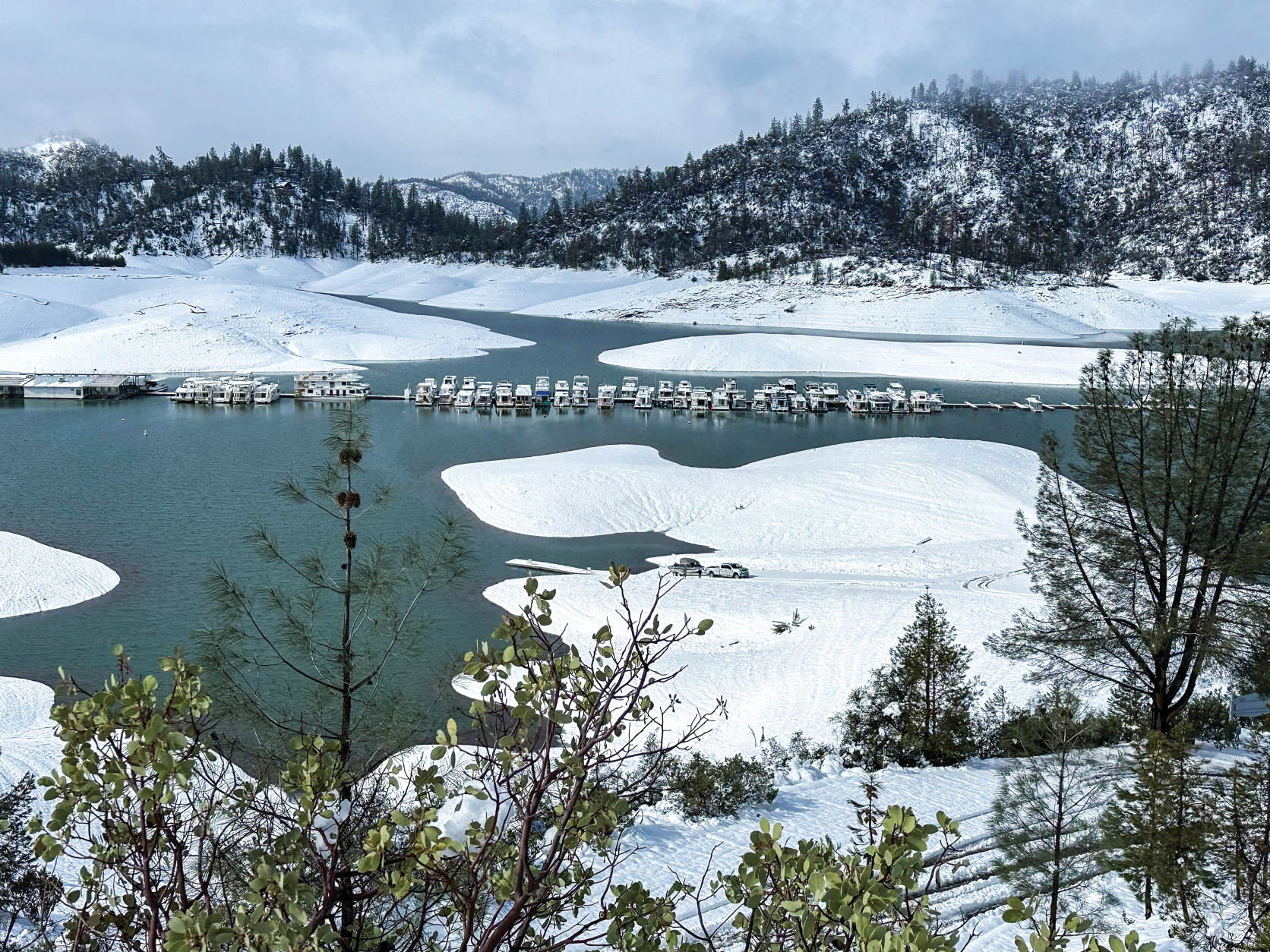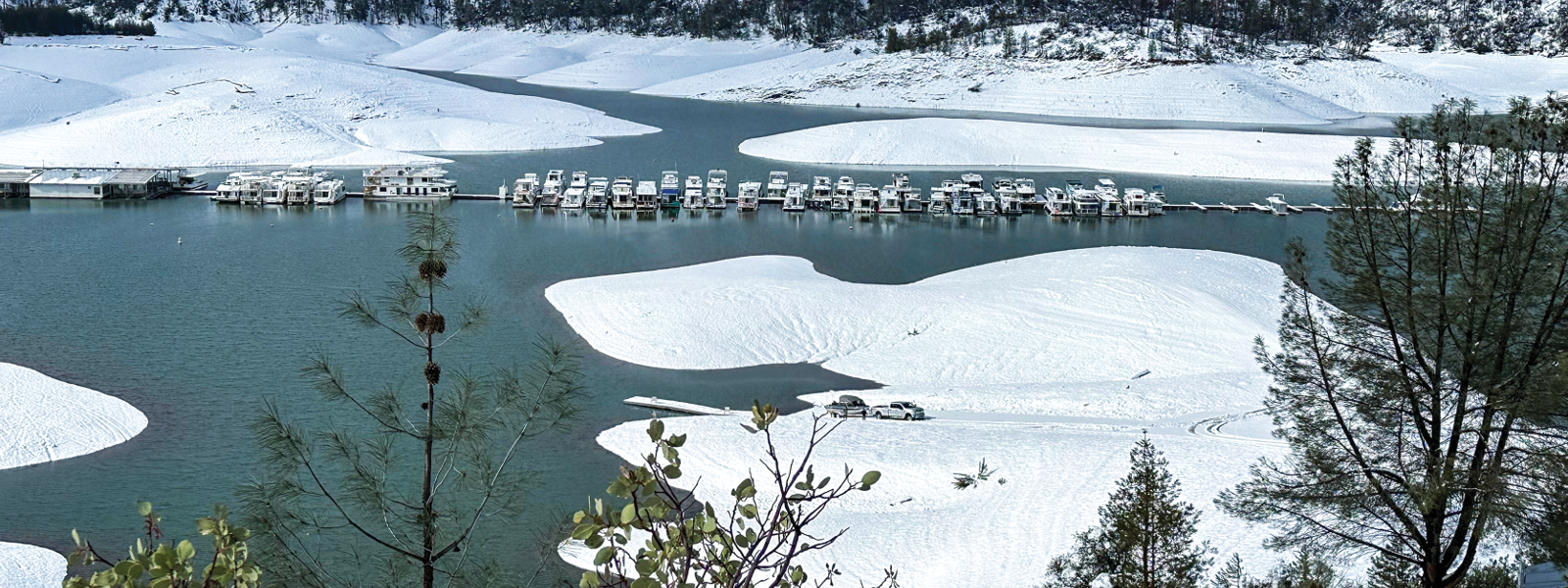Despite storms, water challenges persist

New snow blankets the landscape of Shasta Lake, California’s largest reservoir.

New snow blankets the landscape of Shasta Lake, California’s largest reservoir. Last week, California water officials announced that the statewide Sierra Nevada snowpack was recorded at 190% of seasonal average on March 3. Meanwhile, at a water conference, state officials warned they expect warming conditions to persist and called for partnering on water supply solutions.
By Christine Souza
As still more storms dumped new snow onto California’s burgeoning snowpack, water managers, farmers and environmentalists gathered in Sacramento last week to discuss long-term challenges to secure a more certain water future.
The fresh snowfall contrasted with challenging water realities discussed at the 61st California Irrigation Institute Annual Conference. With a theme of “One Water: Partnering for Solutions,” the event focused on addressing impacts of climate change, including warming conditions and frequent droughts that severely diminish the snowpack and state water supplies.
The gathering emphasized solutions that some speakers said could be aided through partnerships among different water interests.
“We’ve certainly adopted a one water approach, and that really is breaking down the silos within our own utility and then taking that same approach as we think about building partnerships outside of the utility,” said Paula Kehoe, San Francisco Public Utilities Commission director of water resources. “We recognize that there’s definitely opportunities, but it takes a lot of hard work. There are many solutions to our challenges.”
In describing the state’s “hotter, drier new normal,” Karla Nemeth, director of the California Department of Water Resources, which operates the State Water Project, said the state’s water supply is much improved since last December.
Lake Shasta, California’s largest reservoir, was framed by heaps of snow last week. Its water level as of Monday had risen to 83% of historical average. But Nemeth warned that the state’s hydrology is variable, and snow levels in some regions are below average.
“The snowpack is much more intense in the central and southern Sierra, less so in the northern part of the country,” Nemeth said. “In fact, we’re a little bit below average. These storms may push us over that, which would be terrific, but what is important is the northern part of the state is where we have our biggest reservoirs that feed both the state and federal water projects, which is really a backbone of water management here in California.”
Prior to the last few weeks of storms, she said, California had less than an inch of rain from late January to the first two weeks of February. “When it’s not raining, it’s actually getting drier, and that really represents a shift over our observed hydrology over the past hundred years.”
Warmer temperatures, Nemeth said, have water managers looking at the amount of water lost to evapotranspiration.
“We need to develop and appreciate the actual growing sliver of water that is either sinking into the soil or is evaporating given the role of temperature,” she said.
DWR is also focusing on forecasting improvements and looking at soil moisture modeling to better understand how much water can be counted on from storms following dry conditions, Nemeth said.
As part of a panel discussion, Sacramento Valley farmer Fritz Durst discussed his approach to sustainable farming, including the use of no-till and other soil-health practices that retain water and improve yields.
Durst, who grows mainly dryland crops, said “the climate change we’re seeing today has really added a substantial amount of risk” to farming.
“We’re seeing much warmer temperatures in the summertime and colder temperatures in the winter,” said Durst, who farms rice, alfalfa, sunflowers, tomatoes and cereal crops near Knights Landing and is a Sacramento River settlement contractor.
By farming sustainably, Durst said, he uses water to benefit wildlife and fish, and he is able to make a profit.
“We’ve been very proactive in the Sacramento Valley, especially in the rice realm, where besides providing food for human beings, we provide food for shorebirds and waterfowl,” he said. “We provide food for fingerling salmon, and we have a plethora of different types of mammals and reptiles living around our fields. We’re trying to help not just ourselves but the environment we live in.”
Nemeth said water management must emphasize the “need to share the resource, so that we can continue to thrive both economically and environmentally.” She said it is important for water managers to add flexibility to the water system.
To respond to changing conditions, she said, investments must be made in construction of aboveground and belowground water storage, desalinization and water recycling.
Local agencies are working on groundwater recharge and demand management to comply with the Sustainable Groundwater Management Act, a 2014 law that requires efforts to bring depleted groundwater basins into balance.
Jeevan Muhar, general manager of the Arvin-Edison Water Storage District, a federal Central Valley Project contractor based in Kern County, said it is important to invest in construction of new infrastructure and repairs of existing conveyance facilities.
Touting partnerships between agencies as a path to water-management solutions, Muhar described the cooperative relationship the water district enjoys with the large water provider in neighboring Los Angeles County.
“One of our largest partners is the Metropolitan Water District,” he said. “We were one of the first ag-urban partnerships, and I’m proud to say that we continue to have that partnership.
“Talk to your neighbors. Your neighbors might already have those facilities, and you should be able to capitalize on what folks are doing around you,” Muhar added. “I definitely encourage you to think outside the silos and break those down. We have to.”
Working collaboratively with various interests, he said, his district is trying to solve problems, noting that there are “some synergies in working with flood plains and recharge and solving water quality problems all at the same time, so that we can move forward and not continue to fight.”
Robyn Grimm, climate resilient water systems director for the Environmental Defense Fund, discussed work with local partners to develop tools, systems and approaches to manage water and land resources.
“Ultimately, all of us in the room here, we’re trying to get to the same place where our water systems are in balance, and we’re using our water supplies in a way that results in a sustainable and resilient California with ongoing agricultural production, beautiful places to recreate, a strong economy and a healthy environment,” Grimm said. “It is a big lift to get there, and change is really hard, and the system is ever evolving and changing. We need to trust one another and work together.”
(Christine Souza is an assistant editor of Ag Alert. She may be contacted at csouza@cfbf.com.)




